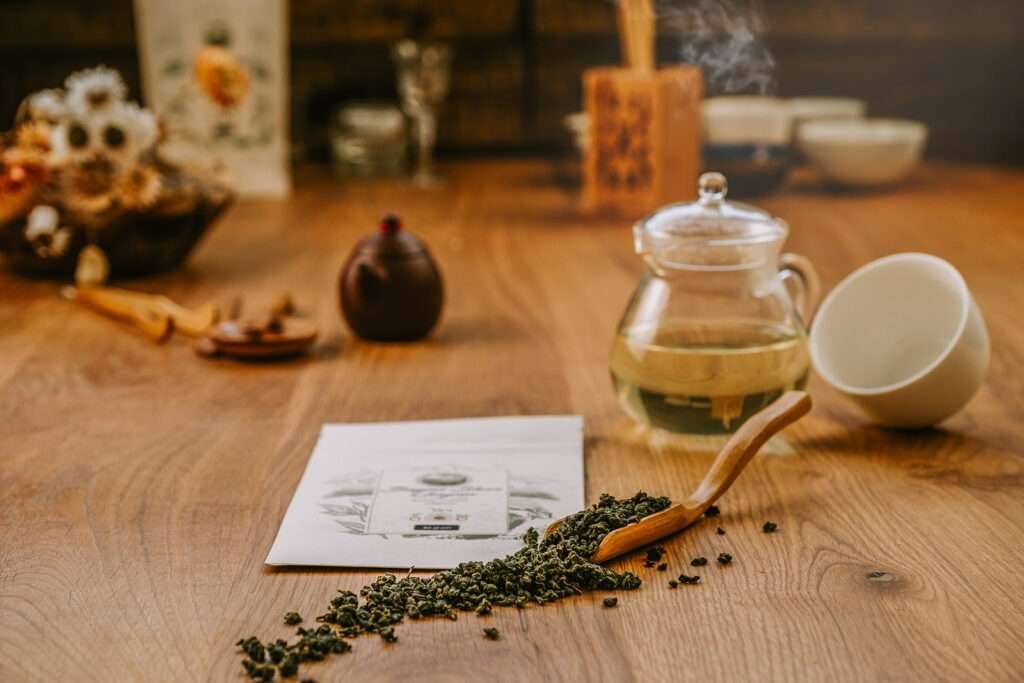Oolong Tea : From Production Methods and Terroirs to Delicious Flavors

Oolong, also wulong (literally, “Black Dragon”), a semi-oxidized tea, falls between the oxidation levels of green and black teas, resulting in a diverse range of profiles, from dark and woody to incredibly light and floral, all of which are characterized by their deliciously smooth texture. A true delight for tea enthusiasts, oolong offers a broad spectrum of flavors and character.
Highly sought-after by connoisseurs, oolong teas boast complex aromatic profiles best appreciated through slow savoring over a course of multiple infusions, traditionally brewed in vessels like a porcelain gaiwan and small clay teapots. This brewing style, often known as gōngfū chá or “high mastery tea,” emphasizes the mindful attentiveness required, contributing to why oolong teas are considered some of the most artisanal teas globally.
This blog post delves into the origins and historical background of oolong tea, shedding light on its production methods and terroirs. Additionally, it provides insights on the optimal way to brew a delicious cup of oolong tea.
The Production of Oolong Tea

Oolong tea production is a meticulous and intricate process that can involve oxidation levels ranging from 8% to 85% depending on the style of tea, resulting in a tea with a bright aroma and a rich, deep taste of complex character.
The cultivar, or genetic strain of the tea plant, is a pivotal factor in oolong production, with the Camellia sinensis species encompassing two primary varieties: the “small-leaf” C. sinensis var. sinensis and the “broad-leaf” C. sinensis var. assamica, each consisting of numerous unique cultivars. Similar to the relationship between wine and grape varietals, tea is intimately tied to both the cultivar and the region of cultivation.
The production process is highly complex, involving specialized techniques such as withering, tossing, bruising, oxidation, rolling, shaping, fixing, and drying. Some oolongs may undergo roasting or baking to enhance a nutty, caramelized sweetness.
The initiation and control of oxidation play a crucial role, with methods like Yao Qing (摇青; literally, “rocking-the-green,” which implies gentle bruising by shaking or tumbling of the leaf’s edges to initiate oxidation) or orthodox rolling tables used in different regions like India and Nepal.
There are two primary shapes for oolong teas:
- long and curly loose leaves
- “wrap-curled” into small beads.
For instance, in Taiwan and Fujian, the ball-shaped oolongs apart from the Yao Qing process might undergo an additional step of cloth-wrapped kneading, which is repeated many times.
The flavor profiles of different oolong styles can vary widely, ranging from sweet and fruity with honey aromas to woody and thick with roasted aromas, or green and fresh with complex aromas. While some consider certain semi-oxidized teas, like First Flush Darjeeling, to be oolongs, debates over categorization persist among tea experts since they are marketed as black tea.
Exploring Different Terroirs

Oolong tea production, originating in China, has evolved to include various terroirs, each contributing unique characteristics to the tea. In Fujian province in China, tea production is concentrated in regions like the Wuyi Mountains and Anxi County.
Notable oolong teas from Wuyi are called “rock/cliff tea” (yancha) and include Big Red Robe (Da Hong Pao), Cassia (Rou Gui), Narcissus (Shui Xian), among others. Anxi is famed for the Iron Goddess of Mercy (Tie Guan Yin). Guangdong produces the floral and fruity Dan Cong teas (单枞) from the Phoenix Mountains (Feng Huang), also known as Phoenix oolongs.
In Taiwan, the diverse climate and geography yield distinctive oolongs like Frozen Summit (Dong Ding), Oriental Beauty (Dong Fang Mei Ren), Alishan, Bao Zhong, Four Seasons (Si Ji Chun), etc.
Additionally, other countries around the world make similar styles or entirely new types of semi-oxidized teas, for instance, in India, we can find Darjeeling and Assam oolongs.
Explore Tea Kulture’s oolong terroirs in Taiwan and Malawi to savor the rich diversity of this exceptional tea.
How To Brew Oolong Tea

For optimal brewing of oolong tea, it is recommended to use 90° water to extract its rich flavors, although the specific style of oolong may influence the preferred water temperature, so be sure to check the brewing recommendations.
Experimentation is also encouraged to discover your most delicious personal preference. Oolong teas offer a lasting taste over multiple infusions, with their character evolving in each steeping. A common technique involves using a small steeping vessel, such as a porcelain gaiwan or Yixing clay teapot, with a higher leaf-to-water ratio, aligning with the gongfu method. Learn more about how to brew a delicious cup of tea.









